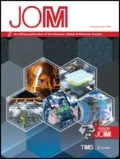Abstract
Transition metal carbides, nitrides, and borides can be called metallic ceramics because they are electronically conductive and extremely hard. Their various applications include cutting and grinding tools, thermal-barrier coatings, diffusion-resistant thin films, interconnects, and superconductivity devices. In each case, the ability of the material to resist or permit heat flow is important. Because of the high concentration of nonmetal atom vacancies in the carbides and nitrides, the carriers of heat—conduction electrons and phonons (the quanta of lattice waves)—are severely scattered, and the thermal conductivity, K, is strongly affected, although differently in high- and low-temperature regions. Measurements of both the electrical and thermal conductivity of single-crystal metallic ceramics at low temperatures and the application of the Callaway formalism help explain the puzzling temperature dependence of K. The finding of a large peak in K of NbC just below its superconducting transition temperature confirms phonon-electron scattering and could lead to a thermal switch. The single-crystal thermal conductivity behavior of TiC and WC is used to interpret the measured K values for cemented carbides TiC/Ni-Mo and WC/Co through a broad temperature range.
Similar content being viewed by others
References
H.O. Pierson, Handbook of Refractory Carbides and Nitrides (Westwood, NJ: Noyes Publications, 1996).
R.E. Taylor, J. Am. Ceram. Soc., 44 (1961), p. 525.
R.E. Taylor, J. Am. Ceram. Soc., 45 (1962), pp. 353–354.
W.S. Williams, J. Am. Ceram. Soc., 49 (1966), pp. 156–159.
W.S. Williams, Phys. Rev., 135 (1964), pp. A505-A510.
P.G. Klemens, Phys. Rev., 119 (1960), pp. 507.
J. Bethin and W.S. Williams, J. Am. Ceram. Soc., 60 (1977), pp. 424–427.
RE. Taylor and J. Morreale, J. Am. Ceram. Soc., 47 (1964), pp. 69–73.
L.G. Radosevich and W.S. Williams, Phys. Rev., 181 (1969), pp. 111–1117.
L.G. Radosevich and W.S. Williams, J. Am. Ceram. Soc., 53 (1970), pp. 30–33.
A.B. Pippard, Phil. Mag., 46 (1955), pp. 1104–1114 and J.M. Ziman, Electrons and Phonons (Oxford, UK: Clarendon Press, 1960).
D.T. Morelli, Phys. Rev. B, 44 (1991), pp. 5453–5458.
L.G. Radosevich and W.S. Williams, Phys. Rev., 188 (1969), pp. 77–773.
J. Bardeen, G. Rickayzen, and T.L. Tewordt, Phys. Rev., 113 (1959), pp. 982.
C. Uher, J. Supercond., 3 (1990), pp. 337.
V.S. Nesphor and S.S. Ordan’yan, Neog Mater., 1 (1996), pp. 480. See also G.S. Upadhaya, Nature of Properties of Refractory Carbides (Commack, NY: Nova Science Publishers, 1996), p. 286.
B. Chakraborty and P.B. Allen, Phys. Rev. Lett., 42 (1979), pp. 736–738.
G.S. Upadhaya, Nature of Properties of Refractory Carbides (Commack, NY: Nova Science Publishers, 1996), p. 285.
M.V. Frandsen and W.S. Williams, J. of Hard Materials, 1 (1990), pp. 159–167.
M.V. Frandsen and W.S. Williams, J. Am. Ceram. Soc., 76 (1991) pp. 1411–1416.
A Perecherla and W.S. Williams, J. Am. Ceram. Soc., 71 (1988), pp. 1130–1133.
K Bachman and W.S. Williams, J. Appl. Phys., 42 (1971), p. 4407.
Additional information
Wendell S. Williams earned his Ph.D. in physics at Cornell University in 1956. He was a research physicist with Union Carbide Corporation, a professor of physics and ceramic engineering at the University of Illinois, and department chair of materials science and engineering at Case Western Reserve University. Dr. Williams, now retired, is a member of TMS.
Rights and permissions
About this article
Cite this article
Williams, W.S. The thermal conductivity of metallic ceramics. JOM 50, 62–66 (1998). https://doi.org/10.1007/s11837-998-0131-y
Issue Date:
DOI: https://doi.org/10.1007/s11837-998-0131-y




